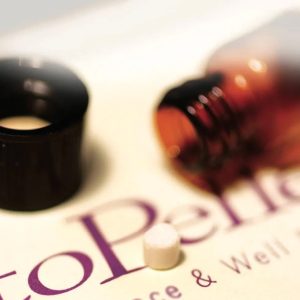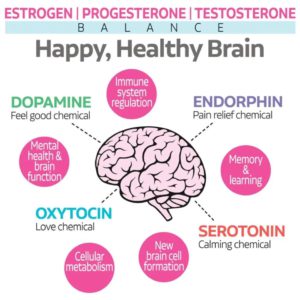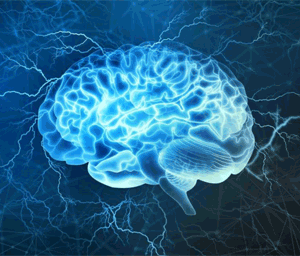Hormones and Happiness: An Insight into Our Brain Chemistry
by Catherine J. Rourke

The brain contains billions of neurons and biochemicals that control every waking and sleeping function of the body. True brainpower involves more than just calculating your next move in a video game. Understanding how hormones regulate the neurotransmitters dopamine, serotonin and oxytocin can help you harness them to boost your mood and well-being for a happier life.

Pioneering physician Dr. Gino Tutera MD, FACOG, an expert in neurodegenerative disorders, described the best approach for health and happiness in his books and presentations as “an inside job.” Maintaining the intricate biochemical balance for optimal well-being and disease prevention formed the heart of his 40-year practice dedicated to restoring the physical, mental and emotional vitality of his patients.
Internationally recognized as the foremost leader in bioidentical hormone replacement therapy (BHRT), Dr. Tutera developed the SottoPelle® Method in 1992. A natural plant-based hormone replacement based on his proprietary bioidentical pellet delivery system, the SottoPelle® Method uses the multi-patented Dosaggio™ dosing site to restore normal physiologic balance.
Speaking on hormones, Dr. Tutera asserted that “Everyone doesn’t wear the same shoe size, so why would they wear the same hormone dose? Think of hormones like the shocks in a car. You can plan on a bumpy ride if they’re worn out.”
As patients reported smoother rides and significant improvements in their vitality, Dr. Tutera observed another remarkable result. Their blues were melting away, along with brain fog, mood swings, memory loss and insomnia. He established a direct link between natural hormone balance, happiness and healing of the mind, body and spirit.
Human health declines despite medical advances
According to Johns Hopkins Medicine data, more than 9.5 percent of U.S. adults 18 and over suffer from depression. The National Institute of Mental Health reveals that 21 million adults experience depression, with the highest episodes among ages 18-25. Studies also indicate that cognitive decline and neurodegenerative conditions now start at earlier ages.
A 2023 Alzheimer’s Association report states that two-thirds of the 6.7 million Americans diagnosed with Alzheimer’s dementia are women.
Dr. Tutera focused extensively on brain health. His groundbreaking research explored the treatment of dementia, depression, Alzheimer’s, Parkinson’s disease, Traumatic Brain Injury and other neurodegenerative conditions.

Concerned with the sharp rise in cognitive disorders like ADHD and anti-anxiety medications, he sought natural solutions without debilitating side effects to transform patients’ lives. Many medical experts agree that, despite modern medical advances, more research is needed on the role of hormones in brain health and to combat disease as the U.S. life expectancy continues to decline.
Hormones for happiness: not all are alike
According to Dr. Tutera, “At age 40, most women have lost normal levels of estrogen and nearly all their progesterone and more than half of their testosterone. And at age 50, most men have lost over half of their testosterone.”
While various factors contribute to these statistics, Dr. Tutera’s passion to improve mental and physical well-being led to some startling discoveries.
“My research shows that hormonal imbalance contributes to 90 percent of depression and mental illnesses,” he said. “I truly believe that pellet therapy could empty out most of the psychiatric and mental health facilities in this country and certainly get patients off the dangerous drugs prescribed for depression, anxiety and panic.”
Neuroscientists are now following his lead, examining the role estrogen plays in cognitive function. Yet a few reports distinguish between synthetic HRT and natural BHRT or pellet methods, triggering fear and confusion about their use.
BHRT pellets are plant-based substances that precisely match the molecular structure and functionality of human hormones. Slipped under the skin, they provide 24-7 hormone delivery. Pellet therapy originated in Europe over 85 years ago and was introduced in the U.S. by Dr. Greenblatt in the 1940s. Numerous studies mention their critical role in hormone optimization for brain health.
The good news is that people can take some simple steps to protect their brains from the ravages of stress and the endocrine disruptors robbing them of clarity, focus, mood and cognitive function. SottoPelle® offers a missing link—the role hormones play in our happiness—in the neuroscience of brain chemistry.
“Hormones set the stage in motion for every single function in the body,” Dr. Tutera explained. “They’re the control panel in charge of releasing every chemical messenger that signals every cell to receive the neurotransmitters to do its job.”
Neuroanatomy: Brain Chemistry 101

What are these neurotransmitters, and how do they work with our hormones to keep our brains healthy and happy?
Over 97 studies in the Handbook of Clinical Neurology highlight the role of sex hormones, especially estrogen, as biochemical messengers in managing the brain’s cognitive and myriad other functions.
Think of the brain as a computer circuit with wires, hoses and connectors controlling railroad track switches. The brain hormone receptors receive the neural signaling from the hormones to release dozens of neurotransmitters, including serotonin, dopamine, oxytocin and endorphins.
Here’s where the happiness factors come in.
Serotonin acts in mood swings. It monitors neuropsychological functions: stress, appetite, memory, digestion and many others. The upswing produces euphoria; downswings cause depression, Seasonal Affective Disorder (SAD), PTSD and anxiety. Estrogen enhances serotonin.
Dopamine controls mood, memory, motivation, movement, concentration, sleep and how we experience pleasure. Low levels lead to Parkinson’s disease and depression. Estrogen boosts dopamine.
Oxytocin, often called the “love hormone,” is triggered by touch, laughter, prayer, music, meditation, exercise, nature, sex, childbirth, bonding with friends or hugging our partners. Low levels lead to stress and depression. Estrogen significantly raises oxytocin binding in the ventromedial nucleus of the hypothalamus, and women produce more of it than men.
When the hormone levels flow in the right balance, everything runs smoothly. We’re happy, cheerful, energized, optimistic, sleep soundly, think clearly and even experience euphoria. But if that delicate balance drops, we have a runaway train racing down the wrong track.
Brain inflammation: unhappy hormones
The stress of modern life can take its toll on us, causing hormonal imbalance, endocrine disruption and, in turn, inflammation.
According to Dr. Tutera, this imbalance suppresses all neurotransmitter functions for the body’s physiological, cognitive and neurological processes. While diet, supplements and exercise help, they don’t address the core problem.
He further offered an analogy that dieting, supplement ingestion and exercising, without addressing the core problem of hormonal imbalance, is like pouring the highest-grade oil on a cracked engine. “The car still won’t run,” he said.
Hormones are the body’s control panel for every organ and function. They restore normal physiology to rebuild that cracked engine so the car will start up again.
“The fault with most natural and traditional approaches,” he said, “is that they presume the individual already possesses the normal physiology—the stage on which elixirs can perform magic.
“But normal physiology can only result from normal hormonal balance because hormones are in charge of releasing every chemical messenger that signals every cell to receive the neurotransmitters to do its job.”
Treating neurodegenerative diseases for a happy brain: Parkinson’s, TBI, Alzheimer’s

Estrogen, in particular, affects the areas of the brain involved with dopamine. It promotes neuronal growth by decreasing inflammation. Growing evidence indicates that estrogen protects the nigrostriatal dopaminergic pathway affected in Parkinson’s disease (PD). It is also noted in the pharmacologic algorithm of the American Neurological Association that estrogen may play a major role in PD symptoms.
The Life Extension article, “Heal Traumatic Brain Injury With Bioidentical Hormones,” further documents the hormone-brain connection and highlights Dr. Tutera’s work using the SottoPelle Method® to treat neurodegenerative conditions – including PD, Alzheimer’s and TBI.
Citing 63 studies, the article explains how BHRT works to penetrate the blood-brain barrier to promote neuronal growth, support cognitive function, and provide neuroprotection. It attributes “disrupted hormone function” instead of brain damage to the neurological symptoms TBI patients experience.
Like many NFL players, former quarterback Jim McMahon turned to the SottoPelle® Method for help with concussions and TBI. He reported improvements in mood, motivation, balance, coordination, energy, mobility and medication assimilation, plus reduced tremors.
Many former NFL players, including Jim McMahon and National Football Foundation Hall of Famer Paul Krause, have turned to the SottoPelle® Method® for help with concussions and TBI. They reported improvements in mood, motivation, balance, coordination, energy, mobility and medication assimilation, plus reduced tremors.
“I’ve been on the pellets for years now,” said McMahon. “I’m able to stay in decent shape without a whole lot of exercise and also feel more alert mentally. I’d recommend the therapy wholeheartedly!”
An industry leader with visionary medicine
Neurobiology may sound complex, but boosting your brainpower is simple with SottoPelle® science.
“While this represents time-revered endocrinology and isn’t rocket science,” said Tutera, “BHRT offers a solution backed by studies in the prevention of serious maladies to offset the development of major diseases.”
According to Dr. Tutera, “This is the only safe, effective approach to eliminating the root of all disease and physical dysfunction by restoring hormonal balance, normal neurotransmitter processes and normal physiology of the body. It’s the best preventative antidote in modern medicine to alleviate the devastating illnesses and often fatal diseases caused by stress.”
As pioneers bringing pellet therapy back into the mainstream with precision dosing, SottoPelle® paved the way decades ago as the visionary industry leader for pellet practices across America.
Today, Dr. Tutera’s wife CarolAnn continues his legacy as president of SottoPelle®, now celebrating 30 years helping more than 250,000 patients worldwide enjoy happier, healthier lives.
“Good health is happiness,” she said, “and it begins with a pellet gently slipped beneath the skin. It’s important to maintain your body’s control panel—your hormonal balance—in perfect harmony while aging gracefully.”
Always consult your physician before beginning any treatment program.
Photos/Illustrations with permission from King Lawrence Photographer/kinglawrence.com
and Andrade Design, California/Andradedesign.com.
Permission granted from former NFL players Jim McMahon and Paul Krause for references and quotes.
Primary Sources
Barth C, Villringer A, Sacher J. 2015 Feb. Sex hormones affect neurotransmitters and shape the adult female brain during hormonal transition periods. Front Neurosci. 2015; 9:37.
Greenblatt RB, Suran RR. Indications for hormonal pellets in the therapy of endocrine and gynecic disorders. Ob & Gyn. 1949 Feb; 57(2):211-420. https://www.ajog.org/article/0002-9378(49)90429-9/fulltext.
Heal-Traumatic-Brain-Injury-With-Bioidentical-Hormones. Life Extension magazine. Feb 2015.
http://www.lef.org/Magazine/2015/2/Heal-Traumatic-Brain-Injury-With-Bioidentical-Hormones/Page-01 [See the long list of studies at the end of this article.]
Hornung J, Lewis CA, Derntl B. Sex hormones and human brain function. Handbook of Clinical Neurology. 2020; Vol. 175: 195-207. https://www.sciencedirect.com/science/article/abs/pii/B978044464123600014X#preview-section-references
Schwartz ET1, Holtorf K. Hormones in wellness and disease prevention: common practices, current state of the evidence, and questions for the future. Prim Care. 2008 Dec;35(4):669-705. doi: 10.1016/j.pop.2008.07.015.
Tutera, Gino, M.D. FACOG. Hope for HRT: Subcutaneous hormone therapy reduces breast cancer incidence – A Case Study by Gino Tutera, M.D., FACOG, Advance for Healthy Aging: September/October 2005: Vol. 1, Issue 3, Page 102
Tutera, Gino, M.D., FACOG. You Don’t Have to Live with It! The Science of SottoPelle®. SottoPelle® Inc, 2012.
Zumoff et al. By age 40, normal premenopausal women have lost at least half of their testosterone production (J Clin Endo Metab1995: 80:1429-1430). https://pubmed.ncbi.nlm.nih.gov/7714119/


